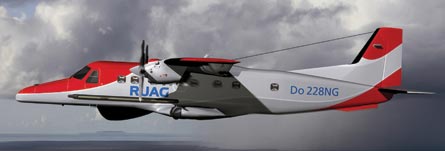The resurrection of the de Havilland Canada Twin Otter and Dornier 228 - unpressurised utility turboprops long out of production - is a reality. Despite much scepticism within the industry, deliveries of both types were achieved this year.
Revival of a similar out-of-production type, the GAF N24 Nomad, has meanwhile gained momentum with a significant cash injection to bring the aircraft to market within two years.
It was at the Farnborough air show in July that Viking Air of Canada disclosed its receipt of Transport Canada type certification for the DHC-6 Series 400 Twin Otter and delivered the first aircraft to launch customer Zimex Aviation of Switzerland.
|
|---|
At the end of July, the company estimated the value of its orders at $200 million, which would suggest an orderbook for close to 50 aircraft and a production backlog to 2014. The most recent addition was a six-aircraft purchase agreement with the Vietnamese navy, in line to take its first ever Western-built aircraft.
Series 400 Twin Otters are scheduled for delivery to Vietnam from 2012-14, and will be allocated to the navy's first fixed-wing air wing. Equipped for amphibious operation, the six aircraft will be configured with convertible interiors allowing VIP, commuter, and utility layouts, with three of the six being Guardian 400 maritime patrol variants. The Twin Otters will be used for transport, resupply, maritime surveillance and search and rescue throughout Vietnamese coastal regions.
The most significant of the 200 changes made to modernise the 20-seat aircraft are the integration of the Honeywell Primus Apex avionics suite, upgraded Pratt & Whitney PT6A-34 engines, and the use of composite materials to save weight.
The updated flightdeck features two primary flight displays and two multifunction displays with high-resolution LCD screens, affording wider viewing and cross cockpit scanning. Other notable changes include a lightweight interior, simplified electrical and LED systems, air conditioning and de-icing.
|
|---|
The Twin Otter is fitted with standard land gear, but has options for amphibious floats, skis, wheel skis, or intermediate flotation (Tundra) gear, ensuring it will continue to operate from remote and unprepared airfields.
A military version, the Guardian 400, has been developed for special missions and government operations. The medium-range maritime patrol and critical infrastructure platform can be outfitted with an electro-optical and infrared imaging turret, a 360e_SDgr digital colour radar system, an extended-range internal fuel tank, crew observation stations, and an air-operable cargo door.
 Ruag Aviation received an extended type certificate for the Dornier 228NG New Generation on 18 August - two-and-a-half years after launch. The Swiss company had flown the aircraft for the first time on 30 July. This example was handed over to launch customer, New Central Airservice (NCA) of Japan, on 23 September, for use on regional services from Tokyo. NCA had already been operating three 228-212s for more than 10 years.
Ruag Aviation received an extended type certificate for the Dornier 228NG New Generation on 18 August - two-and-a-half years after launch. The Swiss company had flown the aircraft for the first time on 30 July. This example was handed over to launch customer, New Central Airservice (NCA) of Japan, on 23 September, for use on regional services from Tokyo. NCA had already been operating three 228-212s for more than 10 years.
Germany's federal office of defence technology and procurement BWB has placed an order with Ruag for a special missions variant of the 228NG that the German navy will use as part of pollution control operations in the German parts of the North and Baltic seas. This aircraft will have an airborne collision avoidance system (ACAS II), a terrain awareness and warning system (TAWS), digital flight data recorders and an advanced emergency locator transmitter as standard equipment. Adaptive high-frequency and satcom systems complete the configuration.
To enhance its capability to detect oil slicks, the 228NG Special Mission version is fitted with new sensors, including a side-looking airborne radar, colour line and IR/UV line scanners, and an electro-optical sensor. An advanced operator workstation enables ergonomic control of the sensors, with display and editing facilities of all collected data. The satcom system allows in-flight transmission of these data to other mission forces.
The 228NG can comfortably seat 19 passengers in airline configuration, but its manufacturer is also targeting the special missions market, extolling the aircraft's suitability for environmental monitoring, border and fisheries control and maritime surveillance, as well as for airlifting cargo and casualties.
Central improvements in the 228NG are upgraded, 775shp (580kW) Honeywell TPE331-10 engines with five-blade composite propellers, a glass cockpit with an improved flight management system and a four-screen electronic flight information system from Universal Avionics, and communications and navigation equipment from Rockwell Collins.
It also features improved aerodynamics to the wing, including coupled aileron droop to boost short-field performance. Safety features include an engine indicating and crew alerting system as standard, with ACAS II, TAWS and autopilot as options.
MARKET
The fuselage, wings and tailplane are manufactured by Hindustan Aeronautics in Kanpur, India, with final assembly and outfitting assigned to Ruag's Oberpfaffenhofen site in Germany. Ruag aims to produce 12-18 aircraft a year and envisages a potential market of 60-80.
India's Mahindra Group, the new owner of Australian general aviation manufacturer Gippsland Aeronautics, plans to invest $20 million in the manufacturer over the next two years. An initial $2 million already invested will fund the new 18-seat GA18 - the relaunched Nomad - and a 10-seat GA10 stretch of the popular GA8 Airvan.
Gippsland Aeronautics has been seeking funding for the GA18 programme since it acquired the certificate of type for the Nomad from Boeing in June 2008.
The type will be powered by new Rolls-Royce 250-B17F/1 turboprop engines with Hartzell propellers, and will incorporate a glass cockpit and various weight-saving measures. Single-pilot operation should increase its appeal.
Last year, the company revealed that it had letters of intent for nine aircraft. Total market demand is forecast to reach 170 aircraft.
Source: Flight International






















